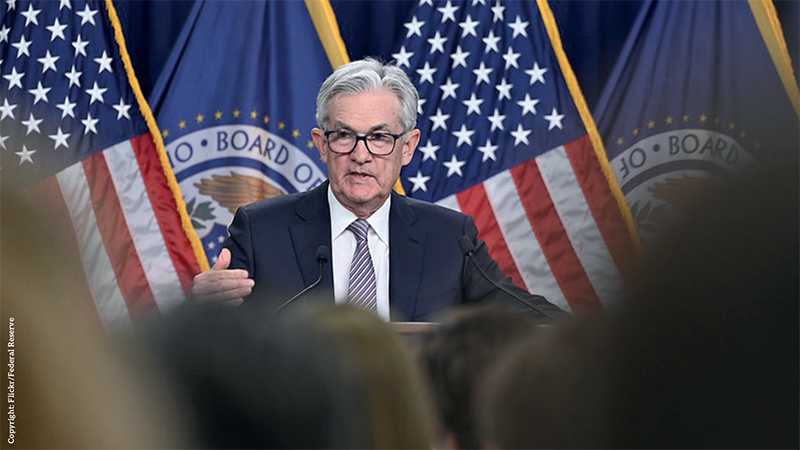Federal Reserve chair Jay Powell has given his clearest indication yet that interest rates are likely to drop at the next meeting.
Speaking at Jackson Hole, he warned that the downside risks to the labour market had increased, while the upside risks to inflation had diminished. Investors have been piling into fixed income markets in recent weeks, but have expectations on rate cuts already moved too far?
An imminent cut from the Fed is welcome news for existing investors in fixed income. It comes on the back of cuts from the Bank of England and European Central Bank.
Yields have already dropped significantly, pushing prices higher. The US 10 year treasury yield has dropped from 4.7% in April to 3.8% today. Global and EUR government bonds have been the best-performing IA sectors over the past month.
However, this exuberance may have gone too far. Investors have been rushing into fixed income. July saw some of the strongest inflows on record for the asset class. Morningstar data showed fixed income strategies gathered €42.6bn of net inflows, their strongest month since June 2019. Invesco data showed EMEA fixed income ETFs pulling in $10.7bn over the same period, the highest month on record.
The majority of those flows have gone into the safer – and therefore most interest rate sensitive – end of fixed income. It has gone into developed market government bonds and high quality corporate debt.
There have also been significant flows into money market funds. Morningstar data showed money market funds had €32.6bn of net new subscriptions, after collecting €28.8bn in June.
See also: FCA lays out plans for traffic light ratings of DC pensions
This could create vulnerabilities. Fixed income markets are already pricing in significant rate cuts. Alex Harvey, senior portfolio manager and investment strategist at MGIM, says: “Market pricing implies a cut of at least 25bps at the next Fed meeting on 18 September.
“A 50bps cut remains on the table and is 30% priced at the moment, but that’s a sharp retrenchment from the near 75bps lower that was reached intraday on 5 August.”
He says that while the data in the US has been mixed, it would not ordinarily point to a 50bps cut: “Yes, the 12-month payrolls revision was sharply lower on Tuesday, and the July number was well below consensus, but other data, including Wednesday’s PMI and jobless claims numbers, recent retail sales figures and robust wages don’t paint a picture of an economy yet teetering on the brink of recession.”
Holger Mertens, senior portfolio manager in the global fixed income team at Nikko Asset Management, agrees that too much may be priced into markets. “There are different camps. There is the camp that don’t think it is excessive and is optimistic on what the Fed will do. On the other hand, there is the view that yield buyers are just trying to get in before yields go lower.
“It looks difficult for the Federal Reserve to deliver all the market expects. If you look at inflation data, it’s coming down. Economic data has softened, but is still pretty reasonable. It all points to a situation where the Fed can reduce rates, but not to the extent expected by the market.”
See also: Are decumulation strategies fit for purpose?
On the other side of the argument is Simon Dangoor, head of fixed income macro strategies at Goldman Sachs Asset Management. He says: “We think risks are skewed towards more policy easing than currently priced in by markets, allowing yield curves to steepen and bonds to provide investors with protection against equity market declines.
“With high starting rates, front-end yields have more room to fall compared to the last cycle. In addition, unlike the previous cycle, where rates were at their lower bound and quantitative easing was necessary, in the current cycle, it is unlikely that the long end of the curve will face downside pressure from unconventional policy easing.”
For investors, the ‘all-in’ yield for fixed income is still attractive, and still ahead of inflation. However, the risks are mounting. Harvey says: “Unless the Fed delivers more than 200bps over the next 12 months, you won’t see much price appreciation in shorter maturity bonds. That said, with a 4% yield you’d be hard pushed to lose money in total return terms, so they continue to hold appeal.”
There may be more to go for in the credit markets. Spreads over government bonds spiked higher in late July/early August, which created some opportunities for investors to buy in at more attractive yields. While spreads have now largely recovered, there are still parts of the market that hold value.
See also: Square Mile reveals income targeting strategies are back on top
Square Mile’s recent ‘Barometer of Fund Manager Sentiment’ showed the consensus was that this was an environment that favoured “dynamic, active portfolio management and fund managers able to identify pockets of opportunity”. For example, several fund teams see Europe as offering interesting opportunities for bottom-up security selection as the eurozone emerges from recession to a modest recovery.
There are also individual sectors likely to benefit from interest rate cuts where it is not fully priced into markets. Mertens gives the example of the utility sector, which is highly indebted and benefits disproportionately from lower rates.
Other capital-intensive businesses should also see strength. “These areas struggled a lot during the period of higher rates, and lower cuts completely change the way the valuations of their asset portfolio,” he says.
This is a precarious moment for fixed income markets. Investors are pushing more capital towards higher quality fixed income markets at a time when market expectations on rate cuts already look optimistic.
While yields are still attractive and alternative scenarios are plausible, an active approach, targeting specific sectors and regions may be a more productive way to harness the higher yields on offer.








